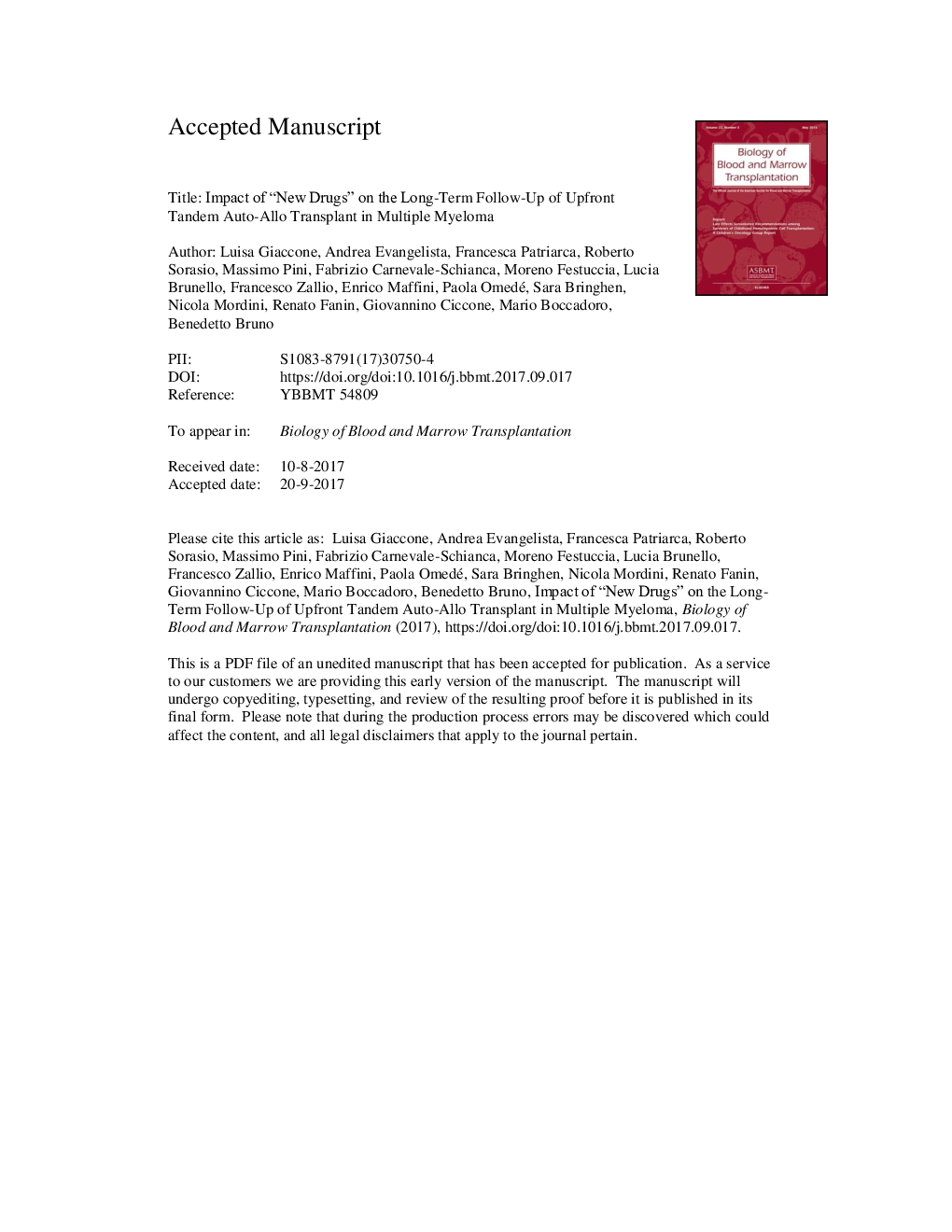| کد مقاله | کد نشریه | سال انتشار | مقاله انگلیسی | نسخه تمام متن |
|---|---|---|---|---|
| 8430642 | 1546233 | 2018 | 14 صفحه PDF | دانلود رایگان |
عنوان انگلیسی مقاله ISI
Impact of New Drugs on the Long-Term Follow-Up of Upfront Tandem Autograft-Allograft in Multiple Myeloma
ترجمه فارسی عنوان
تاثیر داروهای جدید در پیگیری طولانی مدت اتوگرافت-آلوگرافت پس از زایمان در مبتلایان به چندزیستی میلوما
دانلود مقاله + سفارش ترجمه
دانلود مقاله ISI انگلیسی
رایگان برای ایرانیان
کلمات کلیدی
پیوند آلوگنیک، میلوما چندگانه، داروهای جدید، پیگیری طولانی مدت، بیماری مزمن پروستات در برابر میزبان،
موضوعات مرتبط
علوم زیستی و بیوفناوری
بیوشیمی، ژنتیک و زیست شناسی مولکولی
تحقیقات سرطان
چکیده انگلیسی
Before the introduction of “new drugs,” we designed a trial in which 162 newly diagnosed myeloma patients were biologically randomized to receive either an autologous stem cell transplant (auto-SCT) followed by a nonmyeloablative allogeneic stem cell transplant (allo-SCT) or a double auto-SCT. Fifty-eight patients in the allo-SCT arm and 46 in the double auto-SCT arm completed the assigned treatment. At a median follow-up of 12.3 years from allo-SCT and 12.1 years from second auto-SCT, median overall survival (OS) was 11.4 in the allo-SCT arm and 3.9 years in the auto-SCT -arm (Pâ=â.007), whereas event-free survival was 3.6 and 1.5 years (Pâ<â.001), respectively. A subset of allo-SCT patients showed persistent molecular remission. Two-year cumulative incidence of chronic graft-versus-host disease was 67.2%. At 5 years, 39% of these patients were alive, disease-free, and off immunosuppression; 36.6% had relapsed and 12.2% were still on immunosuppression. Thirty-three of 58 patients (allo-SCT arm) and 39 of 46 (auto-SCT arm) relapsed at least once and were rescued with new drugs. In the allo-SCT arm, 2 patients in biochemical relapse did not reach clinical criteria for treatment. Overall 28 (90%) were treated with new drugs and 14 (45%) received donor lymphocyte infusions (DLIs). In 28 of 31 patients (90%) DLIs were given with new drugs. Median OS from first relapse was 7.5 years in the allo-SCT arm and 2 years in the auto-SCT arm (Pâ=â.01). Patients who received DLI showed significantly longer OS (hazard ratio, .38; Pâ=â.042) as compared with auto-SCT patients. This difference was slightly lower when only allo-SCT patients who did not receive DLIs were considered (hazard ratio, .56; Pâ=â.154). In summary, long-term disease-free survival and survival outcomes after treating relapse with new drugs with or without DLIs were better in allo-SCT patients.
ناشر
Database: Elsevier - ScienceDirect (ساینس دایرکت)
Journal: Biology of Blood and Marrow Transplantation - Volume 24, Issue 1, January 2018, Pages 189-193
Journal: Biology of Blood and Marrow Transplantation - Volume 24, Issue 1, January 2018, Pages 189-193
نویسندگان
Luisa Giaccone, Andrea Evangelista, Francesca Patriarca, Roberto Sorasio, Massimo Pini, Fabrizio Carnevale-Schianca, Moreno Festuccia, Lucia Brunello, Francesco Zallio, Enrico Maffini, Paola Omedé, Sara Bringhen, Nicola Mordini, Renato Fanin,
